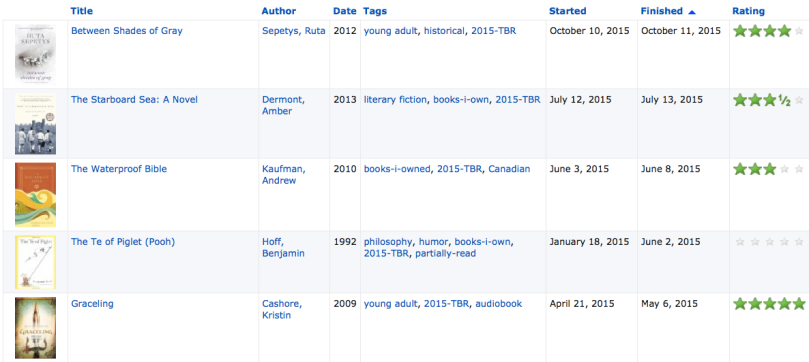See Top Ten Books I’ve Read So Far in 2015 from July 1. I will still talk your ear off about Greenglass House and Graceling. And Trigger Warning and NPH’s Choose Your Own Autobiography are superb audiobooks. Here are ten of the books I’ve enjoyed in the second half of the year:
Emmy & Oliver by Robin Benway:  Emmy’s best friend (and boy-next-door), Oliver, was kidnapped by his father when he was seven; he returns at age 17, and reconnects with Emmy and her friends. Good realistic/romantic fiction for those who liked The Face on the Milk Carton by Caroline B. Cooney and Sweethearts by Sara Zarr.
Emmy’s best friend (and boy-next-door), Oliver, was kidnapped by his father when he was seven; he returns at age 17, and reconnects with Emmy and her friends. Good realistic/romantic fiction for those who liked The Face on the Milk Carton by Caroline B. Cooney and Sweethearts by Sara Zarr.
Slade House by David Mitchell: This haunted house story is a companion to The Bone Clocks, so of course I loved it; there’s no need to read The Bone Clocks to enjoy Slade House, though, so if this is your first foray into Mitchell’s universe, you can start with this more concise novel. The titular Slade House appears every nine years so its inhabitants can harvest a soul to prolong their lives, but the last victim it lures in is on to them. Deliciously creepy. (I got an early copy and wrote the blurb for LibraryReads.)
We Never Asked for Wings by Vanessa Diffenbaugh: Just as good as The Language of Flowers, but with illegal immigration instead of the foster care system and homelessness as the central issue. Not to say that it’s an “issue book”; the Mexican-American characters at the center of the story are real and complex, their dilemmas hard and heartbreaking.
Useful, Usable, Desirable by Aaron Schmidt and Amanda Etches: I’ve already written about this one here. If you work in a library, or design any kind of product or service or platform for library users, read this book!
Being Mortal by Atul Gawande:  I’m consistently impressed with Gawande’s writing ability, and the clarity with which he communicates his message. In this case, he addresses the issues presented by an aging population, on both the societal and the individual level. An important book that is also easy to read.
I’m consistently impressed with Gawande’s writing ability, and the clarity with which he communicates his message. In this case, he addresses the issues presented by an aging population, on both the societal and the individual level. An important book that is also easy to read.
The Dive from Clausen’s Pier by Ann Packer: If you’ve been having second thoughts about settling down with the guy you’ve been dating for years and are now engaged to, and he becomes paralyzed in an accident, do you stay with him? Or do you go? This is Carrie Bell’s decision, and The Dive From Clauden’s Pier is a character study of a young woman making a difficult decision about what she should do, and what that might mean about the kind of person she is.
Modern Romance by Aziz Ansari and Eric Klinenberg: Though I’m no longer in the dating pool, I enjoyed listening to how romance has changed and how it has stayed the same in recent history. The audiobook was great; it’s stand-up comedy backed up with smart social science.
 Unfinished Business by Anne-Marie Slaughter: The author of The Atlantic article “Why Women Still Can’t Have It All” has written a book about the unequal value American society places on competition (ambition, putting oneself first, breadwinning) and care (providing care for children, aging parents, other family members or friends); the former is traditionally male, the latter traditionally female. In order to address gender inequality, we must also adjust the value we place on competition and care.
Unfinished Business by Anne-Marie Slaughter: The author of The Atlantic article “Why Women Still Can’t Have It All” has written a book about the unequal value American society places on competition (ambition, putting oneself first, breadwinning) and care (providing care for children, aging parents, other family members or friends); the former is traditionally male, the latter traditionally female. In order to address gender inequality, we must also adjust the value we place on competition and care.
George by Alex Gino: George is a fourth grader who was born a boy but knows she’s really a girl. But how does she tell her family and friends? And how will they react when she does? This is most likely – hopefully – just the beginning of transgender lit for children and teens, and it’s a sweet, realistic story that avoids extremes: there’s no horrific bullying, but not everyone is instantly accepting either. George’s friend Kelly is a great character also.
Did You Ever Have a Family by Bill Clegg:  A story of grief and guilt, told by multiple narrators – the survivors of a tragedy and those related to them. For those who liked The Illusion of Separateness by Simon Van Booy, How to Start a Fire by Lisa Lutz, The Children’s Crusade by Ann Packer, Fellow Mortals by Dennis Mahoney, The Grief of Others by Leah Hager Cohen.
A story of grief and guilt, told by multiple narrators – the survivors of a tragedy and those related to them. For those who liked The Illusion of Separateness by Simon Van Booy, How to Start a Fire by Lisa Lutz, The Children’s Crusade by Ann Packer, Fellow Mortals by Dennis Mahoney, The Grief of Others by Leah Hager Cohen.
That’s it for me for 2015. If I read any outstanding books in the next week, I’ll tell you about them in January. Meanwhile, what were your favorite books of the year?




